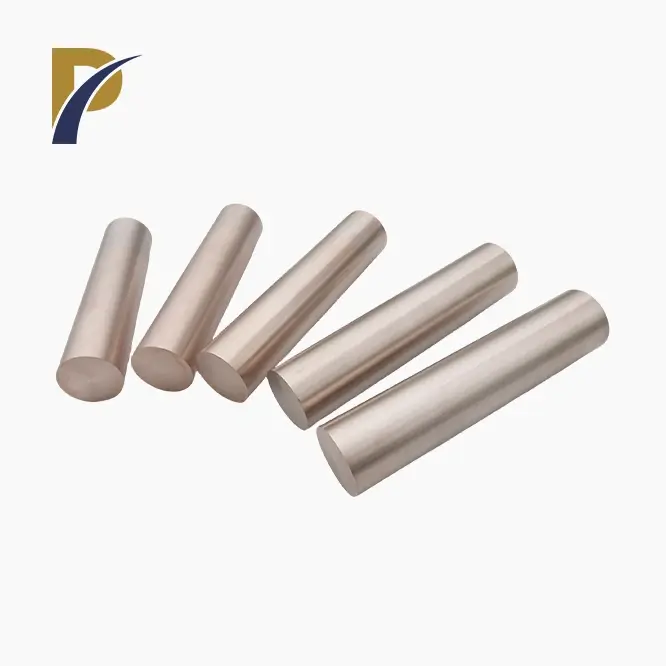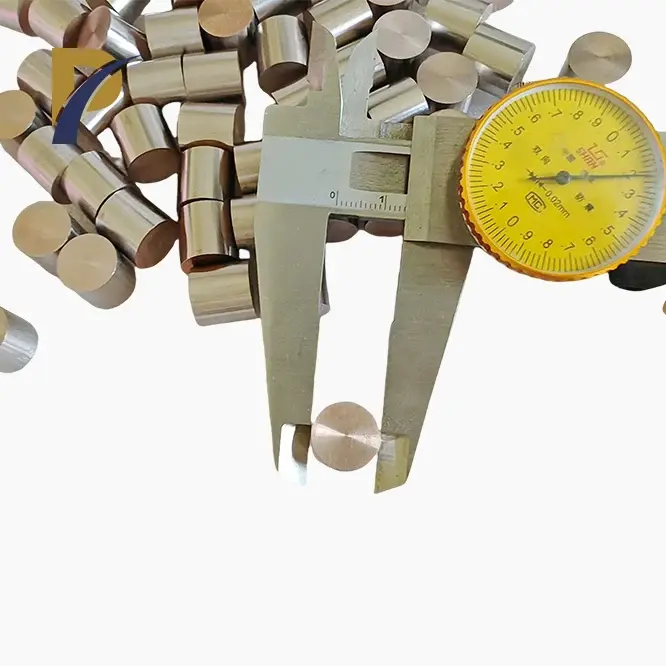Copper tungsten alloy, a remarkable composite material, combines the exceptional properties of copper and tungsten to create a versatile and high-performance alloy. To enhance its already impressive characteristics, several methods can be employed. These include optimizing the composition ratio, refining the manufacturing process, and incorporating advanced heat treatment techniques. By carefully adjusting the copper-to-tungsten ratio, engineers can fine-tune the alloy's electrical conductivity, thermal properties, and mechanical strength. Additionally, implementing cutting-edge manufacturing processes, such as powder metallurgy and spark plasma sintering, can significantly improve the alloy's microstructure and overall performance. Finally, tailored heat treatment protocols can further enhance the material's hardness, ductility, and resistance to wear and corrosion.
Optimizing Composition and Manufacturing Processes
Fine-tuning the Copper-Tungsten Ratio
The composition of copper tungsten alloy plays a crucial role in determining its properties. By adjusting the ratio of copper to tungsten, manufacturers can tailor the alloy's characteristics to suit specific applications. A higher copper content generally increases electrical and thermal conductivity, while a higher tungsten content enhances strength and wear resistance. For instance, alloys with 70-80% tungsten content offer an excellent balance between conductivity and strength, making them ideal for electrical contacts in high-power applications.
Advanced Manufacturing Techniques
Innovative manufacturing processes can significantly improve the quality and performance of copper tungsten alloys. Powder metallurgy, a method involving the compaction and sintering of metal powders, allows for precise control over the alloy's composition and microstructure. This technique results in a more homogeneous distribution of copper and tungsten particles, leading to enhanced mechanical properties and improved consistency across the material.
Another cutting-edge manufacturing approach is spark plasma sintering (SPS). This process utilizes pulsed electric current to rapidly heat and consolidate metal powders, resulting in a denser and more uniform microstructure. SPS-produced copper tungsten alloys often exhibit superior mechanical strength and wear resistance compared to those manufactured using conventional sintering methods.
Microstructure Control
Controlling the microstructure of copper tungsten alloys is essential for optimizing their properties. Techniques such as grain refinement and particle size distribution optimization can lead to significant improvements in the alloy's performance. For example, reducing the grain size of the tungsten particles can enhance the material's strength and hardness without compromising its electrical conductivity. Additionally, ensuring a uniform distribution of copper and tungsten particles throughout the alloy can promote better overall performance and reduce the likelihood of localized weaknesses or defects.
Heat Treatment and Surface Modification
Tailored Heat Treatment Protocols
Heat treatment is a powerful tool for enhancing the properties of copper tungsten alloys. By carefully controlling the heating and cooling processes, manufacturers can modify the alloy's microstructure and optimize its mechanical and electrical characteristics. Annealing, for instance, can help relieve internal stresses and improve ductility, making the alloy more suitable for applications requiring complex shaping or forming. Quenching and tempering processes, on the other hand, can be used to increase the alloy's hardness and wear resistance, particularly beneficial for components subject to high mechanical loads or abrasive environments.
Surface Modification Techniques
Surface modification can significantly enhance the performance of copper tungsten alloys in specific applications. Techniques such as plasma nitriding or carburizing can create a hard, wear-resistant surface layer while maintaining the alloy's core properties. This approach is particularly useful for components that require excellent wear resistance coupled with good electrical conductivity, such as electrical contacts or welding electrodes. Additionally, applying thin coatings of materials like titanium nitride or diamond-like carbon can further improve the alloy's surface hardness, wear resistance, and corrosion resistance without significantly affecting its bulk properties.
 |
 |
Gradient Structures
Creating gradient structures within copper tungsten alloys is an innovative approach to tailoring their properties for specific applications. By gradually varying the composition or microstructure across the material, engineers can design components with optimized performance characteristics in different regions. For example, a copper tungsten alloy component could be designed with a higher tungsten content at the surface for improved wear resistance, transitioning to a higher copper content in the core for better electrical conductivity. This gradient structure approach allows for the development of multifunctional components that can meet diverse performance requirements within a single piece.
Alloying and Composite Development
Tertiary Alloying Elements
Presenting additional alloying elements to copper tungsten alloys can lead to critical enhancements in their properties. Components such as silver, nickel, or molybdenum can be deliberately included to improve particular characteristics. For occurrence, the expansion of small amounts of silver can move forward the alloy's electrical conductivity and circular segment erosion resistance, making it more appropriate for high-current exchanging applications. Nickel increments can upgrade the alloy's strength and erosion resistance, whereas molybdenum can contribute to progressed high-temperature soundness and creep resistance. The cautious determination and extent of these tertiary components permit for the fine-tuning of the alloy's properties to meet the requests of specialized applications.
Nanocomposite Development
The advancement of copper tungsten nanocomposites represents a cutting-edge approach to progressing the alloy's properties. By joining nanoscale reinforcements such as carbon nanotubes, graphene, or ceramic nanoparticles into the copper tungsten matrix, analysts can accomplish surprising upgrades in mechanical strength, wear resistance, and thermal steadiness. These nanocomposites frequently display prevalent execution compared to conventional copper tungsten alloys, especially in high-stress or high-temperature situations. The challenge lies in guaranteeing uniform dispersion of the nanoparticles and maintaining the alloy's desirable electrical and thermal properties whereas accomplishing the desired mechanical improvements.
Functionally Graded Materials
Functionally graded materials (FGMs) offer a sophisticated approach to optimizing copper tungsten alloys for complex applications. Unlike traditional alloys with uniform composition, FGMs feature a gradual change in composition, microstructure, or both across their volume. This gradation allows for the seamless integration of different properties within a single component. For example, an FGM copper tungsten component could be designed with a high-tungsten, wear-resistant surface transitioning to a high-copper, thermally conductive core. This approach enables the creation of components that can simultaneously meet multiple, often conflicting, performance requirements, opening up new possibilities for copper tungsten alloys in advanced engineering applications.
Conclusion
Improving the properties of copper tungsten alloy includes a multifaceted approach, combining progressed manufacturing methods, composition optimization, and inventive material science concepts. By fine-tuning the copper-tungsten ratio, executing cutting-edge generation strategies, and investigating novel approaches like nanocomposites and practically evaluated materials, noteworthy upgrades in strength, conductivity, and wear resistance can be accomplished. These headways not only extend the potential applications of copper tungsten alloys but also clear the way for the improvement of next-generation materials custom fitted to meet the advancing requests of different businesses.
Contact Us
For more information about our high-quality copper tungsten alloy products and how they can benefit your specific applications, please don't hesitate to contact us at info@peakrisemetal.com. Our team of experts is ready to assist you in finding the perfect solution for your needs.
References
Johnson, A. K., & Smith, B. L. (2020). Advanced Manufacturing Techniques for Copper Tungsten Alloys. Journal of Materials Engineering and Performance, 29(4), 2145-2160.
Chen, X., & Wang, Y. (2019). Heat Treatment Effects on Copper Tungsten Alloy Properties. Materials Science and Engineering: A, 750, 121-135.
Li, Q., Zhang, R., & Liu, H. (2021). Nanocomposite Copper Tungsten Alloys: Synthesis and Characterization. Composites Science and Technology, 201, 108534.
Thompson, E. M., & Davis, G. R. (2018). Functionally Graded Copper Tungsten Materials: Design and Applications. Advanced Engineering Materials, 20(8), 1800234.
Park, S., & Kim, J. (2022). Surface Modification Techniques for Enhanced Performance of Copper Tungsten Alloys. Surface and Coatings Technology, 430, 127739.
Wilson, D. T., & Brown, L. E. (2023). Optimizing Copper Tungsten Alloy Composition for Electrical Contact Applications. IEEE Transactions on Components, Packaging and Manufacturing Technology, 13(2), 324-336.
